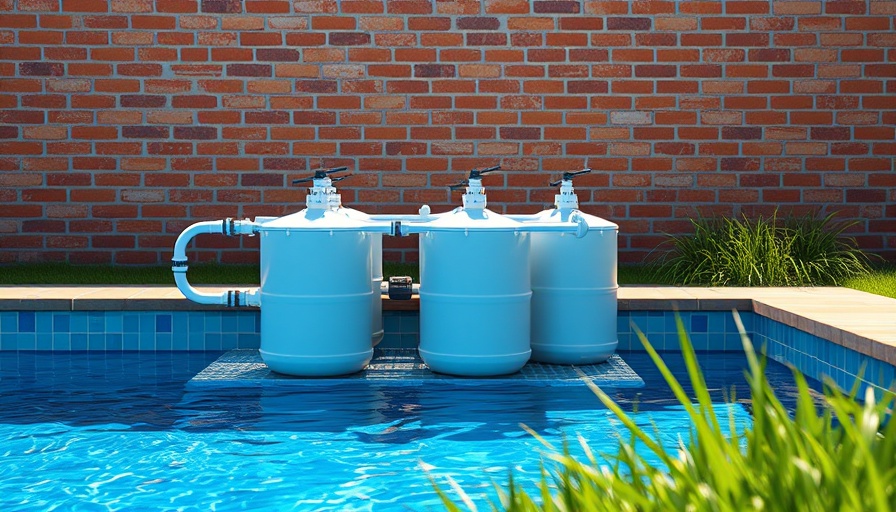
Keeping Your Oasis Pristine: The Importance of Pool Filter Maintenance
As a homeowner, maintaining a clean and inviting pool goes beyond just applying the right chemicals. It's vital to have a well-functioning filtration system that ensures your pool water remains crystal-clear. Just like your body's kidneys filter out impurities, your pool's filter works to eliminate debris and microscopic particles that cloud your oasis. Without proper care, however, this essential system can struggle under the weight of accumulated contaminants, leading to murky water and costly repairs.
Recognizing the Signs That Your Filter Needs Help
Keeping an eye on your filter’s performance is crucial to preventing bigger issues down the line. If you notice reduced water flow from the return jets, an increase in the pressure gauge—typically 8-10 PSI above normal—or cloudy water, it's time to give your filter some love. These signs are early warnings that your filtration system is under stress and may not be performing at its fullest capacity.
The Different Types of Filters and Their Specific Needs
Each type of pool filter has its own maintenance protocol. Sand filters, for instance, typically require backwashing once the pressure rises beyond the normal range. Backwashing reverses the flow of water, removing trapped debris. However, they also benefit from occasional deep cleaning to tackle oils and fine particles. In contrast, cartridge filters need to be removed and thoroughly cleaned every six months during peak usage. A simple hose-down will suffice for general debris, but a specialized soak is crucial to removing oils and stubborn residues. For DE filters, which combine DE powder and grid systems, regular backwashing is necessary, but don't forget to replenish the DE powder after backwashing for optimal filtration efficiency.
A Step-by-Step Guide to Proper Cleaning
Understanding how to clean your filter can significantly extend its life and effectiveness. Start by switching off the pool pump and releasing pressure from the system—a crucial first step to avoid accidents. Take pictures during disassembly for easier reassembly later. For cartridge filters, make sure to gently spread the pleats and thoroughly clean between them. Soaking overnight in a cleaning solution can yield impressive results, restoring your filter to its former glory and maintaining that sparkling water you love.
The Undeniable Benefits of Professional Deep Cleaning
While some maintenance tasks can be handled on your own, don’t underestimate the power of a professional deep clean. Expert technicians utilize specialized cleaning solutions and techniques that can dive deeper than DIY methods, removing deeply embedded contaminants and enhancing the longevity and efficiency of your filtration system. It’s recommended to schedule professional cleanings at least twice per season for optimal performance.
Essential Preventive Maintenance Tips to Remember
Incorporate these preventive measures into your regular routine to enhance the efficiency of your filter system. Maintaining proper water chemistry and regularly skimming the pool reduces debris that can clog filters. Consider using tennis balls or oil-absorbing sponges as clever tools to catch sunscreen and body oils before they reach the filter. Regular brushing of pool surfaces can help prevent algae build-up and further reduce the burden on your filtration system.
Dealing with Filter Media Replacement
Even with the best maintenance practices, components of your filtration system will eventually require replacement. Sand should be replaced every 5-7 years, cartridge filters every 2-3 years, and DE grids every 5-8 years. Regular inspection is key to identifying worn-out components before they can negatively impact water quality.
The Hidden Costs of Neglecting Filter Maintenance
It may seem tempting to skip regular filter maintenance to save money, but this can lead to even greater expenses in the long run. Clogged filters force the pump to work overtime, driving energy costs up and potentially resulting in premature equipment failure. Moreover, neglecting your pool’s filtration system might result in deteriorating water quality which requires expensive chemical treatments to resolve.
In Conclusion: Take Action to Keep Your Pool Pristine
Maintaining a sparkling oasis requires diligence and understanding of your pool’s filtration system. Proper filter maintenance not only enhances your swimming experience but also saves you from costly repairs in the future. Make it a point to keep an eye on performance, invest in professional cleaning, and take proactive steps to maintain your pool's pristine condition.
Ready to ensure your filter performs at its peak? Contact Texas Outdoor Oasis for a professional cleaning and maintenance consultation today! Let our experienced technicians help keep your pool sparkling clean all season long.
 Add Row
Add Row  Add
Add 




Write A Comment